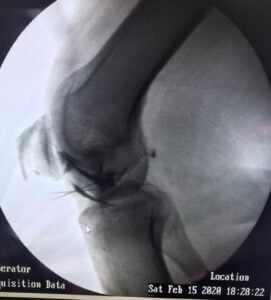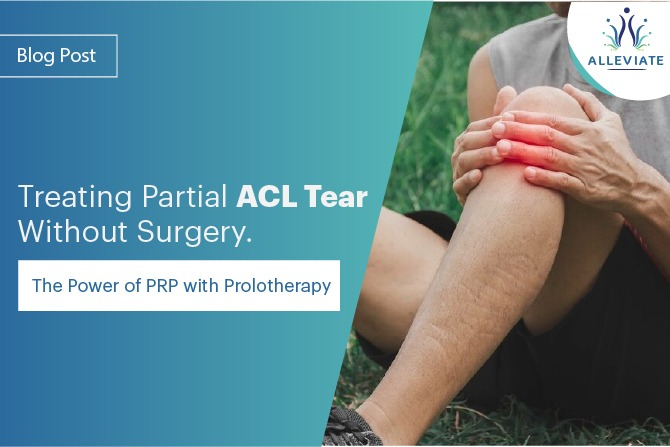Introduction
The Anterior Cruciate Ligament (ACL) is a vital structure in the knee that provides stability during activities involving sudden stops, starts, and changes in direction. ACL injuries are relatively common and can range from partial to complete tears. While complete ACL tears often require surgical intervention, partial ACL tears can sometimes be managed successfully without surgery, thanks to innovative treatments like Image-guided Comprehensive Platelet-Rich Plasma (PRP) with Prolotherapy.


The anterior cruciate ligament goes from the back of the top of the knee- the femur, to the front of the bottom of the knee- the tibia.
In this blog, we will delve into the mechanism of injury for partial ACL tears, explore the symptoms and indications for treatment, and emphasize the effectiveness of Image-guided PRP with Prolotherapy as a standard first-line treatment. This minimally invasive approach not only helps in treating the ACL but also combats degenerative changes in the knee. We’ll also introduce the Alleviate Pain Clinic, where a multidisciplinary approach, including physical therapy and clinical nutrition, is followed to maximize patient outcomes.
Mechanism of Injury


Understanding the mechanism of injury is crucial in comprehending how partial ACL tears occur. ACL injuries often result from a combination of factors, including:
- Sudden Twisting or Pivoting : Many ACL injuries happen during sports that involve sudden changes in direction or pivoting, like soccer, basketball, or skiing. When a person rapidly changes direction or pivots, the ACL can become stretched or torn.
- Hyperextension : Overextending the knee joint, particularly when it’s subjected to excessive force, can lead to partial ACL tears. This commonly occurs when the knee is pushed beyond its normal range of motion.
- Direct Impact : Direct trauma to the knee, such as a tackle or collision, can also cause partial ACL tears. The impact can strain or tear the ligament.
- Non-Contact Injuries : Surprisingly, many ACL injuries occur without any direct contact. In such cases, an individual may abruptly change direction or land awkwardly, putting excessive stress on the ACL.
Symptoms of Partial ACL Tears
Recognizing the symptoms of a partial ACL tear is essential for timely intervention. These injuries may present with a range of signs and symptoms, which can vary in severity. Common symptoms include:
- Knee Swelling : Partial ACL tears can cause mild to moderate knee swelling, typically within hours of the injury.
- Knee Instability : Patients often complain of knee instability, especially during physical activities or when trying to change direction. The knee may feel like it’s giving way.
- Pain : Pain is a common symptom, usually located in the knee joint. The severity of pain can range from mild discomfort to sharp, acute pain.
- Reduced Range of Motion : Patients may notice limitations in their knee’s range of motion, particularly in extension or when trying to fully straighten the leg.
- A Popping Sensation : Some individuals report hearing or feeling a popping sensation at the time of injury.
- Difficulty with Weight-Bearing : Walking or putting weight on the affected knee can be challenging for some patients.
Indications for Treatment
The decision to treat a partial ACL tear without surgery is typically based on several factors. These include the patient’s age, activity level, and the extent of the injury. It’s crucial to establish clear indications for non-surgical treatment, and this is where Image-guided Comprehensive PRP with Prolotherapy comes into play.
- Partial Tear Confirmation : The first step is confirming the diagnosis of a partial ACL tear through clinical evaluation, physical examination, and diagnostic imaging like MRI.
- Patient’s Age and Activity Level : Younger, more active individuals often have a higher likelihood of requiring surgical intervention due to the demands of their lifestyle. However, for older patients or those with less physically demanding activities, non-surgical options can be considered.
- Extent of Injury : The size and location of the partial tear are crucial in determining whether non-surgical options are viable. Small, isolated tears are more amenable to non-surgical treatment.
- Patient’s Goals : The patient’s goals and preferences play a significant role in choosing treatment. Some individuals may prefer a non-invasive approach with a shorter recovery time.
Image-guided PRP with Prolotherapy
A First-Line Treatment Image-guided Comprehensive PRP with Prolotherapy is gaining recognition as a standard first-line treatment for partial ACL tears. This innovative approach combines two regenerative therapies to stimulate the body’s natural healing processes and address the root cause of the injury.
Platelet-Rich Plasma (PRP)
PRP is a concentrated solution derived from the patient’s blood, rich in growth factors and platelets. These growth factors play a crucial role in tissue repair and regeneration. In the case of partial ACL tears, PRP is injected directly into the injury site under image guidance.


Prolotherapy
Prolotherapy, short for proliferative therapy, involves injecting a solution, typically a dextrose mixture, into the injured area. This solution promotes localized inflammation, which in turn triggers the body’s natural healing processes.
The combination of PRP and Prolotherapy enhances the regenerative potential of the treatment, promoting the repair of the torn ACL fibers and surrounding tissues. The benefits of this approach include:
- Minimally Invasive : Unlike surgery, Image-guided PRP with Prolotherapy is a minimally invasive procedure, reducing the risk of complications and shortening the recovery time.
- Regenerative : This treatment focuses on stimulating the body’s own healing mechanisms, promoting tissue repair and regeneration.
- Reduced Pain : Patients often experience less post-procedural pain and discomfort compared to surgical options.
- Faster Recovery : Recovery time is typically shorter, and patients can return to their normal activities more quickly.
- Lower Cost : Non-surgical options like Image-guided PRP with Prolotherapy tend to be more cost-effective than surgery.
- Natural Healing : Rather than relying on artificial materials or procedures, this approach harnesses the body’s innate ability to heal itself.
- Long-Term Benefits : Image-guided PRP with Prolotherapy not only addresses the ACL injury but also helps combat degenerative changes in the knee. It promotes overall knee health and reduces the risk of future injuries.
Alleviate Pain Clinic
A Multidisciplinary Approach At Alleviate Pain Clinic, our focus is on providing comprehensive care for patients with partial ACL tears and other knee-related injuries. We believe in a multidisciplinary approach that combines medical expertise, advanced regenerative treatments, physical therapy, and clinical nutrition.
Fluoroscopic-Guided PRP with Prolotherapy


Patient at Alleviate Pain Clinic undergoing Fluoroscopic guided Platelet Rich Plasma injection for ACL partial tear, PCL strain and Early Degenerative Changes. Image Courtesy- Alleviate Pain Clinic
Our clinic utilizes state-of-the-art fluoroscopic guidance to ensure precise injections of PRP with Prolotherapy. This technology enhances the accuracy and effectiveness of the treatment.
- Physical Therapy: Rehabilitation is a vital component of treating partial ACL tears without surgery. Our team of physical therapists works closely with patients to develop personalized exercise programs that aid in the recovery process, strengthen the knee, and improve stability.
- Clinical Nutrition: Proper nutrition is essential for tissue repair and overall health. We provide guidance on a balanced diet and nutritional supplements to support the body’s healing processes.
- Patient-Centered Care: We prioritize patient education and shared decision-making. Our team works with patients to understand their goals and tailor treatment plans accordingly



